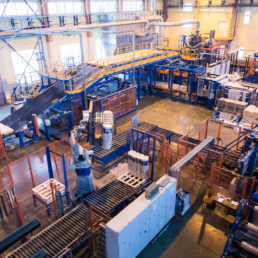Change in mindset essential to make India a global manufacturing leader
According to The Economic Times:
The government has taken major initiatives over the last two years to reduce imports dependency and make India a global manufacturing hub.
While the initiatives are steps in the right direction, a change in the mindset is essential to achieve this target, according to market veteran
“It’s a mindset issue,” Agrawal, the chairman of Motilal Oswal Financial Services, said while speaking at the AIF and PMS Conclave 1.0 Summit.
“The biggest manufacturing exports started happening in Japan and Korea as their domestic market was very small. So, they set up capacities and businesses only for exports. Even the government (policies) were aligned to make it supportive of exports,” Agrawal said.
In India, historically, most manufacturers and entrepreneurs had a huge domestic market and only the surplus was sold in international markets.
Illustrating it further, Agrawal gave the example of the steel industry and the export potential for the sector.
“Everybody (steelmakers) does at the margin exports to the world. Otherwise, nobody can match India in steel competitiveness. We have iron ore, coal, low-cost labour, technology etc..,” he said.
Being the world’s second-largest producer of crude steel, India’s exports slumped to a 5-year low in FY23, largely due to the imposition of export tax by the government. Meanwhile, crude steel production hit a record high of 125.32 million tonnes, with consumption at 119.17 million tonnes.
However, Agrawal is hopeful of the manufacturing theme playing in a big way in the country as the atmosphere is conducive, and India has a huge capability to make it happen.
To make India the global manufacturing hub, the government, in 2020, introduced a production linked incentive (PLI) scheme for 14 sectors, with a total outlay of Rs 1.97 lakh crore.
These include mobile manufacturing, electronic components, speciality steel, medical devices, automobiles and auto components, and telecom and networking products.
“It shows the government’s commitment and mindset towards exports in the manufacturing sector. Let’s see if the global capacities come up…” Agrawal said.
Apple Wants To Make 25% Of Its Products In India, Minister Claims—Backing Up Analysts’ Projections
According to Forbes:
Apple wants to expand its manufacturing in India to 25% of all its products, Indian Commerce Minister Piyush Goyal said Monday, adding credence to reports that the iPhone maker is looking to move large parts of its manufacturing out of China and reduce its dependence on the country following disruptions last year.
Goyal’s estimates are in line with forecasts made last year by JP Morgan that projected Apple will move 5% of global iPhone 14 manufacturing to India by the end of 2022 and expand to 25% of all iPhone manufacturing by 2025. As part of this expansion, Apple is trying to bring in its Chinese suppliers to set up base in India. Last week, various Indian news outlets reported India’s government granted preliminary clearances to 14 of these Chinese suppliers, who will now be required to set up a joint venture with a local firm—a requirement that Indian government officials say is essential to ensure that Indian companies gain manufacturing expertise and other benefits.
KEY BACKGROUND
The minister’s remarks come as Apple is reportedly making efforts to reduce its dependence on China, where it manufactures a bulk of its products. These efforts follow years of growing trade and geopolitical tensions between the U.S. and China and major disruptions to the company’s supply chain last year due to Beijing’s harsh Covid lockdown policies. According to Bloomberg, Apple fell short of its production target for its latest iPhone 14 models by nearly 6 million units worldwide as a result. Protests in Zhengzhou—the world’s largest iPhone factory—saw workers clash with authorities while protesting delayed bonus payments and poor living conditions as nearly all of Apple’s flagship iPhone 14 Pro and Pro Plus models were being manufactured in the factory, which led to stock shortages and long wait times of over six weeks for people looking to buy the top-tier models.
The iPhone maker is set to open Apple stores in India for the first time this year. The stores are part of a deal Apple inked with Indian conglomerate Tata last year to open 100 stores across the country, starting with the city of Mumbai.
India Has Unique Opportunity To Become Global Manufacturing Hub This Decade: Economic Survey
Some have reported that India could become a global hub of manufacturing this decade.
According to NDTV:
India has a unique opportunity to become a global manufacturing hub this decade as foreign companies are adapting their manufacturing and supply chain strategies to build resilience, the Economic Survey said on Tuesday.
The risk of supply chain shocks has never been more palpable than today, following compounding crises from the US-China trade war, the Covid-19 pandemic, and the war in Ukraine, it said.
"In this fast-evolving context, as global companies adapt their manufacturing and supply chain strategies to build resilience, India has a unique opportunity to become a global manufacturing hub this decade," it said.
At present, India's manufacturing sector accounts for about 15-16 per cent of the country's GDP and there is an aim to increase it to 25 per cent in the coming years.
The survey said that the three primary assets to capitalise on this unique opportunity are the potential for significant domestic demand, measures by the government to encourage manufacturing, and a distinct demographic edge.
To further enhance India's integration in the global value chain, 'Make in India 2.0' is now focusing on 27 sectors, which include 15 manufacturing and 12 service sectors and that include furniture, agri produce, textile, robotics, televisions and aluminium.
With an aim to promote Make-in-India programme, the government has launched the PLI (production linked incentive) scheme for 14 sectors
Three Ways Globalization Is Influencing Manufacturing
The move toward globalization has impacted manufacturing in various ways.
According to Manufacturing Business Technology:
There are a range of influences on the manufacturing industry due to the effects of globalization. All global manufacturers, their supply chains and even end-users are impacted by free trade agreements, environmental issues and the demands of responsible sourcing. Let’s delve into three ways that manufacturing industries are being influenced by these factors and how the best global companies are responding to them.
No. 1 - Free Trade Agreements
Free Trade Agreements such, as the CHAFTA legislation between China and Australia, help to create equal and open access to markets for the consumers in participating nations. Such agreements are also meant to benefit all countries involved by creating greater economic opportunities for manufacturers, exporters and material suppliers.
With CHAFTA, the advantages to both parties are clear. Australia is rich in agricultural products and strategic raw materials like iron, nickel and coal — all valuable to China’s industrial infrastructure. On the other hand, China supplies Australia with value-added goods like electronics, machinery and clothing. If a trade partnership goes smoothly like this one has, it’s a great deal for everyone.
But this isn’t always the case and trade partnerships can fall apart quickly and dramatically. This in turn makes life hard for manufacturers in the affected areas, especially when competing against international counterparts who might face better business conditions.
When trade deals are intimately linked to larger political and economic trends it can be hard for global businesses to adapt. This is especially true when a company has no control over the market forces that bring about fluctuations in things like currency exchange rates, import/export duties or energy costs.
A global manufacturer that wants to remain competitive must therefore adhere to a few core strategic principles. These should be centered on offering high-quality products and services, reliable delivery times and low overhead. These factors are valued by product designers, sourcing managers and industrial engineers the world over, and allow for long-term stability in a global marketplace despite temporary and localized economic trends.
No. 2 - Environmental Impacts
As with free trade agreements, international treaties have been drawn up to join nations together to address pollution, resource depletion and climate change.
The best global companies don’t see environmental protection as a regulatory burden. Rather, they use this as an opportunity to continuously improve their processes. This might involve any of the following:
Upgrading machinery and equipment whenever possible to be more efficient while making a smaller carbon footprint
Streamlining procedures to reduce waste and unnecessary or repetitive work
Recycling, re-using or upcycling to keep raw materials out of the waste stream
Partnering with independent, third-party certification bodies like ISO to document and maintain high standards for health, safety and environmental controls
Replacing hazardous or non-biodegradable supplies with ‘green’ alternatives
Companies around the world are facing continued pressures to adopt environmentally-responsible practices to meet global agreements. These measures can provide manufacturing companies with a strategic advantage over many competitors who do not institute best practices, by providing assurances to clients that they’re working with a reputable manufacturing partner.
No. 3 - Responsible Sourcing
Raw materials are routinely sourced from, and shipped to, many places across the globe. As the supply chain extends across continents, it can be difficult to know exactly where the material originated from and whether it meets all international standards for compliance with environmental regulations and honest trade practices. How can a responsible global manufacturer help to ensure the integrity of the resources they consume?
It’s important that manufacturers use reputable material suppliers that are fully certified and these certifications should be confirmed with the local or national government. Manufacturers should refrain from purchasing “cheap” materials, non-branded stock or leftover materials from a reseller, all of which may come from unverifiable sources or which lack a proper chain of custody.
Manufacturers should implement rigorous in-house testing and verification procedures for all incoming raw material. By making this practice a standard, manufacturers can ensure that raw materials are exactly up to specification — an essential part of ensuring high-quality production.
This practice also identifies the presence of banned substances like lead or cadmium, which must be monitored according to the RoHS regulations of the European Union for example. It also alerts manufacturers to suppliers who provide fake, mislabelled or even illegal material.
Manufacturers must always report suppliers who don’t pass testing and verification measures as this helps to create a more robust and reliable supply chain that benefits everyone. After all, responsible global manufacturing also implies being a good global citizen.
The Benefits of Globalization in Manufacturing
Globalization continues to make possible the worldwide exchange of new technologies, finished goods and even new ideas. But along with these opportunities come unique challenges. Those companies that want to take full advantage of the expansion of global trade must also be flexible, rapid to respond to changing conditions, and above all must demonstrate a commitment to providing world-class service and support. Those are universal values that will always be sought after in a global marketplace.
How is India emerging in the global manufacturing sector
India is becoming a new power in global manufacturing.
According to Times of India:
India has the capacity to export goods worth $1 trillion by 2030 and is on the road to becoming a major global manufacturing hub. With 17% of the nation’s GDP and over 27.3 million workers, the manufacturing sector plays a significant role in the Indian economy. Through the implementation of different programmes and policies, the Indian government hopes to have 25% of the economy’s output come from manufacturing by 2025.
Factors influencing the expansion of India’s manufacturing industry:
China’s declining competitiveness
India is presently in a good position to benefit from China’s declining competitiveness as a result of its substandard product quality, trade disputes, and border problems. Moreover India is reorienting its trade policy to take advantage of the increasingly popular China-plus-one strategy. This is basically a strategy in which companies avoid investing only in China and diversify their businesses to alternative destinations.
Huge opportunities for Indian producers have been created by a ban on the importation of Chinese goods. By 2030, the Indian manufacturing sector might boost the world economy by more than $500 billion a year. India improved significantly from its ranking of 142 in 2014 to 63 in 2020 for ease of doing business.
Heavy dependence on the service sector
Also, the pandemic has highlighted the service industry’s flaws and made policymakers realise that depending too heavily on the service sector may not be a good idea for the economy .
This led to the government stepping up its efforts to promote the manufacturing industry by providing a variety of incentives and promotional programmes to business ventures, start-ups, and entrepreneurs.
More over manufacturing activity leads to the creation of large employment in several service sector areas too.
In addition, India’s abundant supply of raw materials makes it a particularly desirable destination for manufacturing companies. India’s low labour costs, which are between a third and a fifth of those found in developed countries, increase its appeal.
Market opportunities
India also has a huge capacity to participate in global markets because of factors like electricity expansion, long-term employment possibilities, young and educated population and skill paths for millions of people. Their potential is influenced by a number of things. First of all, India’s assets in terms of raw materials, industrial know-how, and entrepreneurship are well positioned to benefit from these value chains. Additionally, they can benefit from four market opportunities, including contract manufacturing, localising imports, increasing exports, and increasing internal demand.
Digital transformation
Technology has today encouraged creativity, with digital transformation being a critical element in gaining an advantage in this increasingly competitive industry. The Indian manufacturing sector is steadily moving toward more automated and process-driven manufacturing, which is projected to improve efficiency and enhance productivity.
Government initiatives
The National Manufacturing Policy aims to raise manufacturing’s GDP share to 25% by 2025. The “Make in India” campaign (covering 25 economic sectors) and the Production-Linked Incentive Scheme (4 percent to 6 percent incentives on incremental sales), the latter of which was presented in the Global Economic Prospects Report of the World Bank released in the month of January earlier this year, are some of the noteworthy programmes under which new business ventures in the manufacturing sector can benefit in a variety of ways. It is clear why India’s manufacturing sector grew by 210 percent in FY ’22.
India has a very active and strong start-up ecosystem. In reality, the Ministry of Micro, Small & Medium Industries in India allows anyone to register a business for free online (MSME). The demands are straightforward. Numerous micro and small industries are thus emerging across the country.
Investments in the Manufacturing Sector in India
The following are a few examples of recent significant investments and developments in this industry as per IBEF statistics:
The Department for Promotion of Industry and Internal Trade (DPIIT) estimates that in FY 2021–2022, India received a total inflow of US$ 58.77 billion in foreign direct investment (FDI).
From April 2000 to March 2022, the automobile industry received US$32.84 billion in foreign direct investment.
(Excluding fertilisers) The chemical manufacturing sector saw FDI inflows of US$19.45 billion.
The manufacturing of drugs and pharmaceuticals saw FDI inflows of US$19.41 billion.
In June 2022, the production of coal, cement, power, refinery products, fertilisers, steel, and natural gas drove the total index of the eight core industries to a value of 143.4.
Production grew for coal by 31.1%, electricity by 15.5%, goods from refineries by 15.1%, fertilisers by 8.2%, cement by 19.4%, and natural gas by 1.2% in June 2022.
The Manufacturing Purchasing Managers’ Index (PMI) for India was 53.9 in June 2022.
The export of the top 10 major commodities from January to June 2022 totaled US$ 190.4 billion and included engineering goods, petroleum products, gems and jewellery, organic and inorganic chemicals, drugs and pharmaceuticals, electronic goods, RMG of all textiles, cotton yarn/fabric/madeups, rice, plastic, and linoleum.
81 lakh net customers were added by EPFO in May 2022, an increase of 1.45 lakh net subscribers from April 2022.
Some of the biggest companies in the world, including but not limited to General Electric, Siemens, HTC, Toshiba, and Boeing, are setting up manufacturing plants in India as a result of the “Make in India” policy. The rising purchasing power of Indians is another factor supporting this growth. Therefore, these enterprises hope to draw both individual Indian consumers and companies that sell goods created in India.
Conclusion
Each year, China exports commodities worth more than $2.5 trillion, of which $490 billion goes to the US alone. The US-China trade war has given Indian businesses access to a sizable market.
Currently, India is regarded as the second most popular country in the world for manufacturing. The development of industrial clusters, the automatic route’s allowance of FDI up to 100%, the accessibility of bank loans, and other factors are driving India’s manufacturing sector’s expansion. To expand at an exponential rate, Indian manufacturers must concentrate on creating cutting-edge products, seizing export prospects and focus on productivity & efficiency through technology implementation, target global volumes to obtain global cost competitiveness.
The Economic Argument For Moving Manufacturing
According to Forbes:
The ongoing supply chain crunch has hit the vast majority of the manufacturing sector. In a 2020 McKinsey survey, 73% of respondents encountered problems with suppliers during the pandemic.
That’s leading to a new push for regionalization in manufacturing, especially in industries like medical devices, where shortages of critical goods aren’t possible. Market forces have been shifting since the start of the pandemic to give regional manufacturers an advantage over far-flung competitors. The shorter and stronger the supply chain, the thinking now goes, the better. This forces every manufacturer to ask a fundamental question: should we keep production where it is or move someplace else?
There’s a compelling economic case to question where your product is produced. It has arguably never been more advantageous to shift some or all of production away from stalwarts like China to one of the many viable alternatives. It has never been more urgent, either, to embrace whatever it takes to prevent the next supply chain crisis. But there’s also a huge cost involved with packing up production and moving to a new country or continent. And for private equity backers, investors and CFOs, the price tag of relocating may overshadow the long-term economic advantages.
It’s a hard sell. Nonetheless, this transformative moment is no time to sacrifice long-term strategic positioning for short-term savings. To get the holdouts on board, frame the argument in financial terms. Here are the economic benefits of moving manufacturing.
Getting Closer To Customers
Locating production closer to current and potential customers downstream in the supply chain facilitates commerce. By working in similar geographies and overlapping time zones, producers can shorten lead times, improve service delivery and offer greater levels of customization. Some locations offer additional advantages to offset the strengths of China, including stronger IP protection and low-tariff or tariff-free trade. Relocation opens the door to new revenue growth along with new revenue streams that wouldn’t be possible from the current production locale.
Leveraging Cost Savings
Mexico and Malaysia now outrank China in the BCG Global Manufacturing Cost Competitiveness Index based on factory wages, productivity growth, currency exchange rates and energy costs. In fact, the most-recent index challenges many expectations about which countries deliver the greatest value for manufacturing. For example, moving may lower the overall cost of production, not to mention the savings on shipping, which has ballooned in cost since the pandemic began. Opportunities to leverage new production methods like a hybrid of in-house and outsourced production or partnering with a shelter provider could further lower production costs from what they are currently.
Building Resilient Supply Chains
The Covid-19 pandemic is just the latest crisis to disrupt the global supply chain. Supply chain issues affect both demand for goods and supply of materials to make those goods — they’re catastrophic in economic terms. These issues have become common enough to rank as a major economic inhibitor. And with so many disruptive forces on the horizon (climate change, inflation, trade wars), production based in the wrong location could be in serious jeopardy. Moving manufacturing preemptively insulates a producer from unruly supply chain problems that could plague other producers.
Positioning For The Future
Recent history proves that distance only compounds supply chain issues. And while the same forces that stretched supply chains across the globe in the first place haven’t disappeared, they will look much different in the wake of Covid-19. As the incentive structures within manufacturing put increasing value on proximity to customers and suppliers, moving sooner rather than later comes with distinct advantages. The ability to capture new customers in markets with high demand and little competition, for one. The greatest advantage, however, will be adopting a production strategy (and location) based on present and future conditions rather than one committed to a past that isn’t relevant anymore.
It’s important to emphasize here that the economic case for moving is strong in some instances and weak in others. Even though there’s been a push for migrating manufacturing, whether as reshoring, nearshoring, dual-sourcing or regional outsourcing, these options are not universally beneficial. They may not even be viable.
Which circles back to the initial question: stay or move? The answer will be unique to each manufacturer and only make sense after a close, critical look at the production footprint. Conducting this analysis, both for the current production orientation and the alternatives (which may include complementary production in several regions rather than an outright move), will be vital for positioning future production wherever it can thrive. It also makes the economic case that much stronger for any skeptics.
India’s Opportunity to Become a Global Manufacturing Hub
India has the potential to be a global manufacturing hub.
According to World Economic Forum:
Beyond the unprecedented health impact, the COVID‑19 pandemic has been catastrophic for the global economy and businesses and is disrupting manufacturing and Global Value Chains (GVCs), disturbing different stages of the production in different locations around the world. Furthermore, the pandemic has accelerated the already ongoing fundamental shifts in GVCs, driven by the aggregation of three megatrends: emerging technologies; the environmental sustainability imperative; and the reconfiguration of globalization.
In this fast-evolving context, as global companies adapt their manufacturing and supply chain strategies to build resilience, India has a unique opportunity to become a global manufacturing hub. It has three primary assets to capitalize on this unique opportunity: the potential for significant domestic demand, the Indian Government’s drive to encourage manufacturing, and with a distinct demographic edge, including considerable proportion of young workforce.
These factors will position India well for a larger role in GVCs. A thriving manufacturing sector will also generate additional benefits and help India deliver on the imperatives to create economic opportunities for nearly 100 million people likely to enter its workforce in the coming decade, to distribute wealth more equitably and to contain its burgeoning trade deficit.
The World Economic Forum’s new White Paper entitled Shifting Global Value Chains: The India Opportunity, produced in collaboration with Kearney, found India’s role in reshaping GVCs and its potential to contribute more than $500 billion in annual economic impact to the global economy by 2030. The White Paper presents five possible paths forward for India to realize its manufacturing potential.
The insights presented in the White Paper reflect the perspectives of leaders from multiple industries in the region. The five possible solutions include:
· Coordinated action between the government and the private sector to help create globally competitive manufacturing companies
· Shifting focus from cost advantage to building capabilities through workforce skilling, innovation, quality, and sustainability
· Accelerating integration in global value chains by reducing trade barriers and enabling competitive global market access for Indian manufacturers
· Focusing on reducing the cost of compliance and establishing manufacturing capacities faster
· Focusing infrastructure development on cost savings, speed, and flexibility
“For India to become a global manufacturing hub, business and government leaders need to work together to understand ongoing disruptions and opportunities, and develop new strategies and approaches aimed at generating greater economic and social value”, said Francisco Betti, Head of Shaping the Future of Advanced Manufacturing and Production, World Economic Forum.
“A thriving manufacturing sector could potentially be the most critical building block for India’s economic growth and prosperity in the coming decade. The ongoing post-COVID rebalancing of Global Value Chains offers India’s government and business leaders a unique opportunity to transform and accelerate the trajectory of manufacturing sector”, said Viswanathan Rajendran, Partner, Kearney.
This White Paper aims to serve as an initial framework for deliberation and action in the manufacturing ecosystem. The World Economic Forum, in collaboration with Kearney, will continue to develop this agenda by working closely with the manufacturing community in India to generate new insights, help inform discussions and strategy decisions, facilitate new partnerships, and provide a platform for exchanges with the global community.
Smart sustainable manufacturing: benefits of outsourcing
There are many benefits to outsourcing your manufacturing efforts.
According to Manufacturing Digital:
It’s no secret that businesses are always looking for new, improved ways to reduce costs and better meet increasingly high customer expectations. Competitor pressure, reduced cycle times and increasing demand have meant that many companies are turning to outsourcing to keep up. And it’s clear to see why - the logic is that we should focus on our own skills, and seek others with complementary skills to complete projects we cannot.
It’s no longer enough to simply be successful, instead, businesses are now looking to streamline processes and create a sustainable business model that works long-term. For businesses that don’t have the capacity or skills to handle certain processes internally, outsourcing is ideal. So what are the benefits?
Improved productivity and efficiency
A lack of available resources can hinder an organisation’s ability to meet demand, but outsourcing can help to make this process much more efficient. By working with a company that specialises in specific processes or services, and leveraging these particular skill sets, you’ll end up with a more productive, efficient service, often of much greater quality than if you attempted the same in-house. As your business won’t necessarily be equipped with the latest and most innovative tools or processes, you’ll also benefit from access to capabilities otherwise inaccessible or too costly.
When outsourcing is involved, businesses are able to focus their resources on core services or projects, meaning they have a higher capacity for production and concentrate on what they do well. Alternatively, manufacturing businesses can outsource skilled work by temporarily hiring experts to work with them on a fixed-term basis.
Greater Flexibility
In order for any business to grow, they need to remain flexible, offering new products or services before their competition. However, finding the time to invest in this innovation can be costly - both financially and when it comes to time. Outsourcing work offers businesses the ability to access skills, abilities and technologies, without a lengthy hiring process or the cost of new machinery, which is invaluable.
Similarly, the flexibility and potential to scale up or down in line with demand is yet another positive. This is because companies usually have a larger capacity for work, so can respond quickly to demand. For example, if a sudden increase in production is required, or businesses receive a contract for a large, one-off project, they don’t need to panic about suddenly increasing productivity because they can simply outsource what they can’t offer in-house.
By taking a flexible and scalable approach, businesses can be sure that they’re able to adjust to the ever-changing demands and conditions, whether that's downscaling or extending operations, enabling them to quickly and easily respond to changing priorities and requirements.
Reduced Costs
It goes without saying that the main priority for any business is reducing overheads, and outsourcing can go a long way towards helping businesses to keep costs down. Not only does it mean they don’t need to invest in developing infrastructure or expensive machinery, but it also removes the need to spend money on complex training or skilled hires, as the work is completed by those who are already experts in their field.
Furthermore, if companies are outsourcing labour only, it not only reduces the number of employees on the company payroll but also allows for the flexibility of increasing or decreasing staffing needs as required.
Encourages Innovation
Improvements in the area of innovation is an additional advantage of outsourcing, as new processes, products or services can be brought to life much quicker due to an increase in resources and capabilities. On the other hand, much in the same way that businesses are now expected to achieve more, so are the suppliers they are outsourcing to. Where, before, businesses would use outsourcing as a way to free up internal time, they are now working alongside their suppliers to drive innovation.
This collaboration means that businesses can take advantage of specific expertise and skills, along with the latest technology, techniques and production processes, leading to a greater competitive advantage within their industry.
What are some risk factors?
While outsourcing comes with a huge range of benefits, it is not without risk. And there are a few things businesses should consider before jumping in:
Quality control - When specific processes or services are outsourced, even though expectations, limits and tolerances are discussed, things can still easily go wrong. Similarly, if working with international business, quality becomes a much bigger issue, due to long lead times and the possibility of disruptions or extra costs. To help minimise the risk, it’s important to agree on detailed product specifications or even an independent quality inspection, and businesses should make sure they have a clear process in place to ensure staff can easily communicate with the outsourced supplier.
Reputational risk - We all know that, when it comes to business, reputation is everything. When outsourcing, especially internationally, it’s important to make sure operations are being handled in a way that meets your businesses standards and values to avoid any negative repercussions. For example; what are their working conditions like? Do they employ underage workers? Will cultural differences complicate communication? It’s a good idea to contact foreign chambers of commerce and trade associations to find out what laws and regulations are in place before you decide to work with a supplier to help identify and minimise any risks or possible problems.
It’s not difficult to see how outsourcing can be hugely beneficial to a wide range of industries, from engineering to manufacturing, but it’s important that businesses look for respected, credible suppliers who offer the quality of service you need. Not only does outsourcing allow businesses to be better, faster and more efficient, it also allows them to focus their energy on the core offerings, meaning they are able to become much more efficient and productive which, in the long run, is a more sustainable business plan.
7 Benefits of Outsourcing to India
Considering outsourcing your manufacturing to India? Here are seven reasons why you should.
According to Teamly:
A rising number of organizations are looking for better, more efficient ways to improve their business processes and save on costs. One of the ways in which a company can make this happen is by outsourcing essential and non-essential functions to a third party either inside, or outside, the United States. One of the most desired outsourcing destinations in the world is India.
India has become an in-demand and increasingly popular resource for those looking to outsource some work outside the country. According to Classicinformatics, 80% of firms in the US and Europe chose India over any other country for their outsourcing needs. There are a variety of benefits as a result of choosing to outsource to India – the talent pool alone is expansive, offering more opportunities – that can help streamline and create a robust (and international) workflow process within the company. Here is what you need to know about outsourcing to India. Let’s first define outsourcing.
What is Outsourcing?
Outsourcing is the practice of hiring a third party to complete services or other business functions that originally were done in-house by the company’s own employees. One of the most prevalent examples of this in action is within the Information Technology (IT) field. Some companies may choose to hire IT developers or tech support from another business without making them employees of the organization as it helps cut down on costs. Other areas that are frequently outsourced include one-time projects, marketing, customer service, or financial services. Let’s take a look at another small example. A small business has a need for editing services for its marketing materials. Instead of hiring a new employee to do this work (or increasing the workload of one of the existing team members), the company decides they’ll hire a contractor to perform the essential functions needed for editing only. This saves the company time and money when outsourcing this particular need and helps free up the team to focus on their main objectives.
It’s important to keep in mind that when considering the possibility of outsourcing work, there are three distinct types:
Offshoring – Outsourcing work to a different, distant country
Nearshoring – Outsourcing to a neighboring country often with the company’s own time zone
Onshoring – Outsourcing within the company’s own country
Offshoring and nearshoring have been the most popular choices for a company looking for a way to save on costs.
What are the benefits of outsourcing?
Outsourcing may prove beneficial to an organization for many a variety of reasons:
Opens up a wider possibility for talent – Companies will have more access to a variety of different skills, resources, and experiences. Most importantly, the availability of highly-specialized skills in widely considered challenging fields becomes an appealing option for companies looking to provide a competitive edge.
Allows the core team to focus on main goals – If a company decides to outsource some of the more time-consuming, non-essential business functions, then the core team can focus on its main objectives, have more room to implement strategic decisions, complete more company-wide goals, and get more work done faster.
Streamlined processes – With parts of the work outsourced to a different firm or company, the organization as a whole can review, clarify, and refine more of its internal operations, create streamlined processes that make sense for the entire team and execute on best practices that benefit the company.
More flexibility to meet the demands of the market – As with any business, the market constantly fluctuates. Outsourcing parts of the business operations can help create a flexible way for the team to meet any changes from external clients and provide everyone with resources to meet the demand.
Access to more innovation – Outsourcing some work can also mean increased collaboration between thought leaders and experts in their respective fields. This exchange of ideas can allow for more creative thinking between the two companies – an opportunity to learn from the other. Outsourcing could even potentially lead to other areas of evolved partnership.
Lower labor costs – When a company chooses to outsource, there are lower labor rates or reduced (or no) fringe benefits costs. According to CapitalCounselor, the top reason why 70% of companies decide to outsource is cost reduction.
Tailored services – Whether it’s a single project that needs to be outsourced or an entire division of the business, outsourcing can provide a simplified way to find a way to get the work done efficiently and quickly. It’s completely tailored to the business need, with professionals highly skilled in that specific niche. For example, if a business is looking to outsource its accounting division, engaging with a company specifically involved in the financial industry can open up a wealth of opportunities at a fraction of the cost.
While there are indeed many benefits to outsourcing, we should also consider some of the disadvantages.
What are the disadvantages of outsourcing?
With outsourcing, of course, comes some risk:
Time-zone differences – Especially if the company chooses to offshore some of its business practices, a drastic time-zone difference can have huge ramifications on the team and workflow. It takes careful planning and coordination to ensure all relevant parties are included in essential meetings and decision-making processes. Time-zone differences will also need to be accounted for when it comes to project management. If a few individuals on the team are in a variety of time zones, this will need to be considered when setting up a timeline for when assignments are due. If not managed correctly, this could create some delays (and misunderstandings) in the delivery of final projects.
Language barriers – Outsourcing to a different country also comes with having potential language barriers that could make certain tasks difficult. Unfortunately, some messages or instructions can be lost in translation or misinterpreted entirely. If the outsourced company doesn’t have a firm understanding of English, translators aren’t readily available, and the internal team doesn’t know how to carefully and tactfully communicate in a way that bridges the gap, there are bound to be many complications in the process, which could cause heavy delays and setbacks. Offshoring can also present some cultural barriers in addition to language ones. For example, cultural barriers can affect how employees and contractors interact with each other, share ideas, or manage disagreements. It can even seep into relevant areas such as negotiation, trust development, and prospective deals.
Loss of some control – When a company decides to outsource some of its work, that means potentially losing some control over those particular processes. The company loses some of its grip on monitoring how the work gets done. This means trust plays a heavy role in outsourcing. It may take a few cycles of consistent, high-quality work to achieve this level of trust and reliability.
Hidden Costs – Outsourcing work is generally perceived as being a cost-saver, however, companies must still be extra cautious about lengthy contracts, making sure they have their HR or legal department read any commitments thoroughly. There could be hidden fees, unexpected costs, or higher hourly rates that the company didn’t account for.
Increased Criticism – One of the major criticisms of outsourcing is the idea that more work opportunities and chances to further develop one’s professional career are given to outsourced companies, particularly outside the US, which has drawn criticism over the years. Much of the complaints are inevitable, with some of the public having a strong opinion about outsourcing to other companies overseas. It’s important to keep in mind the company’s needs and if outsourcing is truly a way to create a better and bigger future for the internal team.
Now we have defined outsourcing, how it can benefit organizations, and the various disadvantages companies may come across. With India being a favored resource for outsourcing, let’s talk about why companies choose to outsource to India.
Benefits of Outsourcing to India
India is likely on its way to becoming a tech leader by the year 2030, which is just one of the many reasons why companies decide to outsource to India. According to OutsourceAccelerator, India ranks as one of the top resources for outsourcing, especially for its services in IT and Software Development. Here are some of the other most important factors that make India such a vital asset in the global market:
Little to no language barrier – One of the major disadvantages of outsourcing to a different country is the language barrier. According to Maps of the World: Top 10 English Speaking Countries, India ranks at the top of the list at number two with just over 125 million people being English speakers – the second largest in the world after the US. This means that communication with an Indian workforce will likely be smooth and the language barrier minimally disruptive, opening up some avenues in which they can provide additional services like customer support.
Increasing talent pool – The talent pool in India increases each and every year. Another statistic from Classicinformatics states that over 3.1 million graduates from various colleges and universities are added to the growing job pool. With this massive amount of knowledge flowing into India’s workforce, outsourcing companies have a wide variety of different levels of expertise and skills they can rely upon to deliver outstanding work. Talented experts in their field are brought on to make meaningful contributions to the company, which in turn, can result in a fluid exchange of ideas, increasing cultural competencies, and can create a multicultural appeal. Additionally, the onboarding process moves rather quickly. Under regular circumstances, a company needs to go through a full and fair recruitment process in order to hire the perfect candidate. However, the hiring process in itself can be a long road. From the posting of the job ad to sourcing, interviews, and finally selection, the prospective employee must then undergo a background check which can take anywhere between a few days through a couple of weeks (and assuming there are no glaring red flags that would cause a company to rethink their decision). After this, the onboarding procedure can begin with a selected start date and an additional meeting with the company’s HR department to complete all the necessary legal paperwork. When a company outsources to India, skilled professionals are available almost immediately. Once the contract is reviewed and signed, these professionals can start right after the agreement is fully executed.
Unparalleled IT workforce – The Indian workforce supplies one of the world’s most robust IT services and offerings. Booming with advanced technology and excellent web customization, navigation, solutions, and development, the Indian IT workforce has been known to stay on top of emerging trends in technology to meet the demands of this specific field and advance their skills. The infrastructure devoted to IT services has boasted big companies such as Trigent, Clarion Technologies, Netgains, Qburst, and GirnarSoft. According to a white paper by Backoffice Pro, the Indian IT industry has expanded into the US, Europe, and Latin America. Over 200,000 graduates are added every year to the Indian IT workforce, resulting in India having the youngest employable population in the world (the average being 29 years of age). In the age of digital advances, this particular population will be key in the development of the technology market and its evolving innovation.
Reduction in costs – Because of India’s large population and cost of living, there is a lower cost for labor. This is a stark contrast to the US which has a high cost of living compared to the major of other countries. When you factor in all the different variables that go into an employee’s overall cost including the cost of fringe benefits, equipment needed to perform the job efficiently, taxes, competitive pay package, and other incentives (especially for a higher-level position), the cost of US labor can be quite high. According to the same white paper by Backoffice Pro, a developer in the US can cost a company $50-80 hourly, compared to an Indian developer who could charge as low as $15 hourly. This drastic reduction in cost can allow a company to have more flexibility within its budget and make strategic decisions towards its staffing needs depending on its unique circumstances.
High-quality work – Because of the level of skill and expertise from the highly-trained Indian workforce required in various business markets, the result is likely in high-quality work and services. In order to provide the best quality, the Indian workforce is usually up-to-date on the latest trends and the technology needed to facilitate a fast transfer of work with opportunities to collaborate and share ideas and resources frequently. Not only is the turnaround time reduced, but the work also comes at a much lower rate.
Stable Government – With India’s stable government and one of the world’s largest democracies, this minimizes the risk of any international work disruption that could potentially wreak havoc on internal work processes.
Ensures a company is sufficiently staffed – Another major benefit of outsourcing to India is building a layer of reliability and retention for the core business team. If the workflow ever threatens to overwhelm the team, a company can then rely on its outsourced team to provide support where needed. An efficient way to do this in the workplace is to assign certain tasks to the contractor, ensuring that they still receive meaningful work and preserving the workflow of the team.
There are a variety of benefits that come with outsourcing to India, and it’s easy to see why companies would choose India as its number one choice in outsourcing considering all the valuable advantages. While the IT field prevails as India’s most valuable source of expertise, there are other areas of business that benefit from outsourcing to India.
Extensive Industry Coverage
It isn’t just IT services that have gained huge momentum over the years as one of the top choices for outsourcing to India. Other vital areas of business outsourced to India include:
Retail
Media
Manufacturing
Customer support/services
Accounting/Financial/Payroll services
Data management
Call center
Software development
Human Resources
Procurement
There is much opportunity here for a company to outsource these different functions. As a result of this wide range of services, India remains in the top position as the world’s most preferred country for offshoring services.
In Conclusion
There is an increasing number of benefits when a company decides to outsource to India. Aside from cost savings and a wider talent pool, a company has a chance to expand its global network and influence and create streamlined processes that benefit its entire system. 68% of companies in the US now frequently outsource their services in hopes of alleviating their core team and building a method of operations that ensures high-quality services and outcomes.
While it’s certain that there are many advantages to outsourcing to India, it’s equally as important to understand some of the risks naturally associated with any type of outsourcing decision for a business. It’s essential for companies to remember that a full assessment of their needs is vital in this decision. It must be an absolute necessity for the current state of the team and the organization in order to begin the process of outsourcing its services as there could be some unexpected costs. However, if the demand is present after a careful examination of the company’s business processes, then the benefits of outsourcing to India could outweigh any risk.
Advantage India: 5 factors that make India an ideal manufacturing destination
India is the ideal global manufacturing destination.
According to ET Edge Insights:
Business disruptions caused by the pandemic has made it a priority for international enterprises to diversify their production centers and expand the markets they cater to, with the aim to make their supply chains more resilient.
India offers several strategic advantages to global conglomerates. A sizable local market and a booming private sector, complemented by a geographical location suitable for exports are some of the benefits that made several MNCs in the electronics, engineering, automotive, chemicals, food processing and healthcare sectors to set up their manufacturing operations in India. Here’s exploring the top five factors that has turned India into a global manufacturing magnet.
India’s Future Perfect Stature
India is home to a strikingly young population and by 2030 would account for world’s largest working age population. India is also projected to become the third largest consumer market by 2030, with expected consumer spending to grow to almost USD 6 trillion. Indian government has committed USD 1.5 trillion to improve energy, transport, logistics, industrial, social and urban infrastructure under NIP. All these factors and a swelling tech-savvy population with high digital adoption, second only to China, makes India one of the most advanced destinations for business.
Government Support for a Conducive Manufacturing Ecosystem
The current Indian government propagates the concept of think global, act local, serve ‘glocal’. Several central and state government initiatives have been taken to attract foreign investment in India as a part of the “Make in India” drive. It has already garnered USD 357 billion in Foreign Direct Investment since FY2014. Numerous policy-level reforms, improvement of industrial infrastructure, liberal FDI and foreign trade rules, and fast-tracking of projects with customized support for large projects are exemplary of some such initiatives.
Attractive Tax Rates
As per the new tax reforms, the effective Corporate Tax rate (including surcharge and cess) for new manufacturing companies in India is as low as 17.16% – one of the most competitive in the world. Various state governments have also announced tax-based incentives across several manufacturing segments.
Competitive Cost of Doing Business
The cost of setting up and operating a manufacturing unit in India is globally very competitive. Several Indian states have liberalized labor laws and the cost of quality labor in India is drastically low in comparison to China, Mexico and Thailand. Power rates in India are at par with China and lower than Brazil, Thailand and Mexico.
Ease of Doing Business
In the global ease of doing business index, India climbed 79 spots in the last 5 years and holds the 63rd position, as of 2019. Fast tracking of multiple government processes, setting up special courts to accelerate legal proceedings and resolution of disputes, and implementation of easier exit policies have helped in improving India’s ease of doing business.
Apart from the afore mentioned factors, Indian government is also making sure that a substantial number of global requirements around sustainability are addressed. The country is also improving its logistics and infrastructure for faster and seamless transportation of consignments. Various steps have also been taken for pandemic proofing of supply chains.
World’s 5th largest economy, India has a strong and stable government that is progressively working towards making the country conducive for global manufacturing operations. The whole package that India is offering is so lucrative that global conglomerates have taken notice. Many have already started their operations and many more are considering setting up their manufacturing bases in India to avail these benefits without wasting any more time.










